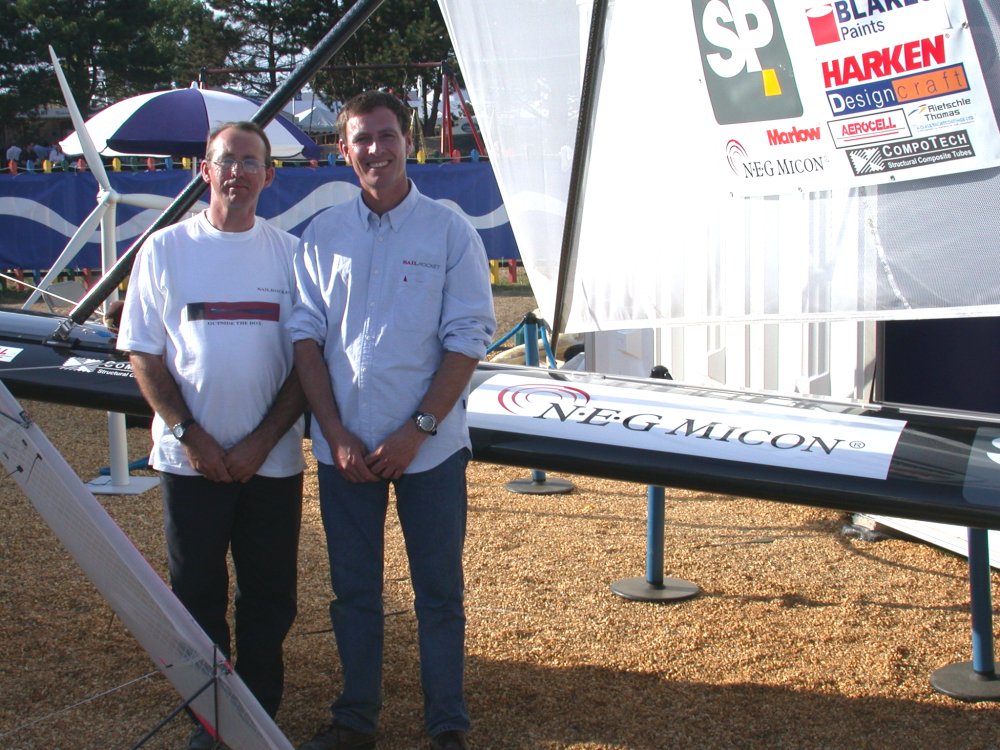
SailRocket - Thinking outside the box
by Mark Jardine 17 Sep 2003 07:53 BST

Malcolm Barnsley & Paul Larsen together with SailRocket at the 2003 Southampton Boat Show © Mark Jardine
The race to reach the 50 knot barrier has become the equivalent of going supersonic in an aircraft. It is a milestone that many sailors and windsurfers have tried to reach, but so far all have fallen just short. SailRocket could be about to change all this with a totally new design and way of thinking about speed sailing design.
The Team
Designed by Southampton engineer Malcolm Barnsley who has been involved in speed sailing for 25 years and piloted by Paul Larsen who already has five speed sailing records to his name, the team have the credentials to be taken very seriously indeed. They are supported by a talented team and companies including N.E.G. Micon, SP Systems, Compotech, Design Craft & Harken.
The Concept
Previous record attempts have used weight to counterbalance the force of the rig, so much of the driving force is used to counteract this drag. SailRocket has equalised the forces creating a perfect balance between the rig and foils. There is no heeling moment, so all of the drawing power is converted into speed. Over the last two years this theory has been tested and proved to work using a scale model and hours of tank and wind tunnel testing.
The rig is very efficient through the air and will be capable of driving the design to above 50 knots. The team have identified that the limiting factor will be the foils. At very high speeds conventional foils have a tendency to cavitate or ventilate when the vapour point of the water is reached. Overcoming this will result in the record being broken.
Various designs of foil are being considered and built ready for the team to test. Due to SailRocket only needing to run in one direction for a record attempt the foils are asymmetric and angled inwards to keep the hull in the water. The angle is adjustable easily as this is one of the most critical components of the design. In fact the entire planning area of the windward hull is interchangeable to get the hull form just right.
Making the foils is an expensive process. A single daggerboard and rudder are custom made using new moulds each time and constructed using some of the highest modulus carbon available. They then must be finished to a perfect shape since the slightest imperfection could cause the cavitation they are trying so hard to avoid. The cost for each pair is a massive £3,000.
Pre-attempt testing
The aim now is to have the boat ready for a wet launch at the London Boat Show. The sails and crossbeam are complete and the moulds for the hulls are ready so this looks attainable.
Financially they have had good support from their sponsors and suppliers so far but a title sponsor is needed for the testing and record attempts. They are hoping to secure and announce a major company for this by the London Boat Show as well.
Early next year they aim to start their testing. Currently they are evaluating sites in Belgium, Holland, Sandy Point in Australia and a ‘secret location’ in the Middle East.
Paul Larsen rightly pointed out that “testing is great but the real world is different”. The hulls are purposefully over-engineered to stand the rigours of life on the road and accidents that may happen during testing. The whole craft weighs in at 155kg.
Once they are at a venue they are dependant on getting the right wind conditions. For 50 knots they need flat water and 22 knots from 100-110 degrees to the angle of the course.
The record attempt
Once the testing is complete the team want to return to the UK for a public record attempt. Chesil Beach is a favourite due to the easy public access and possibly ideal conditions. They also want this to be true British record, designed in Britain, made in Britain and attained in Britain.
What if it doesn’t work?
If conventional foils don’t provide the answer then the team can move to a sharp entry cavitating foil. The team haven’t fully done the calculations on this concept but they reckon that the drag would increase by a third which would necessitate the move to a solid wing sail. The concept of the hull remains the same so this isn’t a project that will be assigned to the scrap heap if it doesn’t work first time.
The team is highly experienced, knowledgeable and has the drive necessary to see this project through and capture the world speed record. If all works they may move speed sailing and potentially fast sailboat design to a whole new level. Watch this space...
More Information: